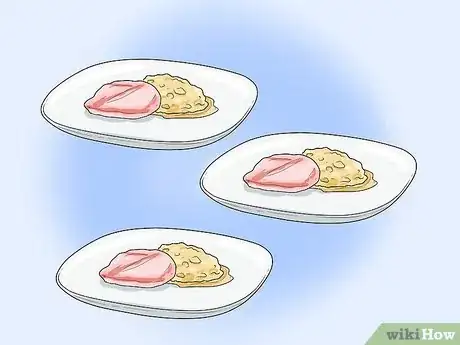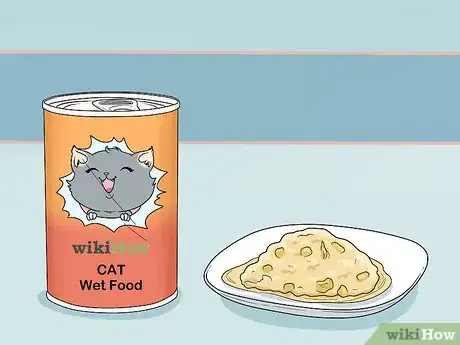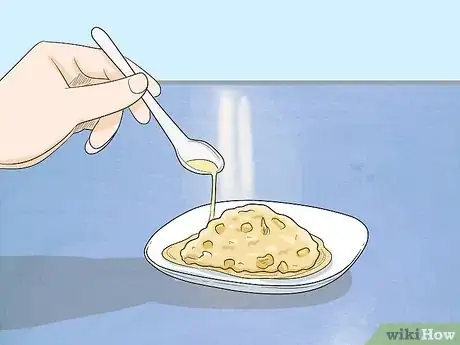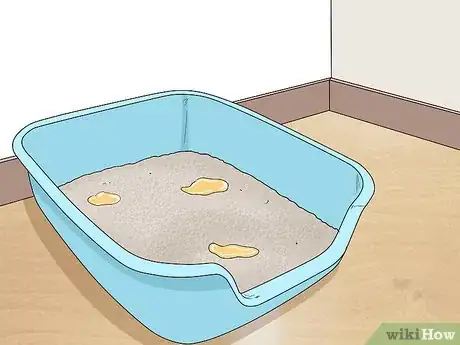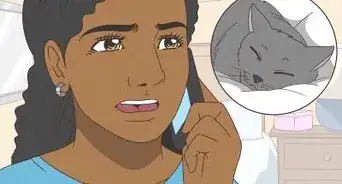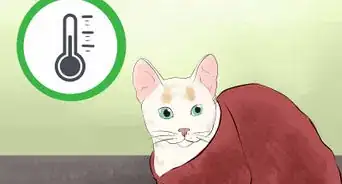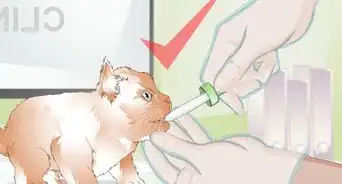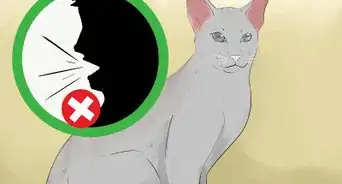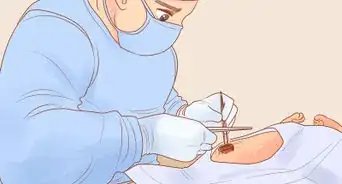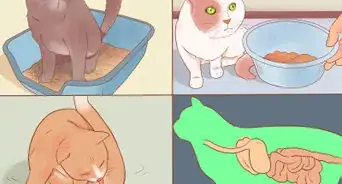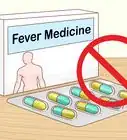This article was co-authored by wikiHow Staff. Our trained team of editors and researchers validate articles for accuracy and comprehensiveness. wikiHow's Content Management Team carefully monitors the work from our editorial staff to ensure that each article is backed by trusted research and meets our high quality standards.
This article has been viewed 124,776 times.
Learn more...
Cats’ urine is naturally a little acidic, with an average pH value of around 6.0–6.5. If house cats are frequently dehydrated and eat a diet of primarily dry food, their urine will become alkaline and have a pH value higher than 7.[1] If this happens, the cat may be at risk for a variety of urinary illnesses, often grouped under the umbrella category of feline lower urinary tract diseases (FLUTD).[2] To lower the cat’s urinary pH, feed it canned or raw food, and make sure that it’s drinking plenty of water.
Steps
Altering Your Cat’s Diet
-
1Feed your cat several small meals during the day. Giving your cat a single large meal every day will boost the alkalinity of their urine. To avoid this, plan to feed your cat 4–6 small meals throughout the day. This will even out their body’s intake of nutrients and calories, and should prevent a spike in the cat’s pH alkalinity.[3]
- For example, give your cat a small scoop of food at 8am before you leave for work and another at 5pm when you get home. Then give the cat 2 more scoops of food later in the day, around 7pm and 10pm.
-
2Give your cat wet food instead of kibble. In nature, cats get the majority of their water from the food they eat. Domestic cats are healthiest—and have the best urinary tract health—when they also receive plenty of hydration through their food. If you currently feed you cat kibble, switch the dry food out for a high-quality wet food.
- For comparison, kibble contains from 5–10% water, while wet food contains about 75% water.
- Kibble dehydrates cats who eat it, and is high in carbohydrates, which cats’ bodies are not prepared to process.
Advertisement -
3Dampen your cat’s kibble if they’re resistant to eating canned food. Cats are notoriously picky eaters, and it can take time for a cat to change their diet. If your cat doesn’t take to the canned food right away, you can add more water content to its dry food to get the cat used to a wetter meal. Scoop up a handful of water, and use your fingers to sprinkle it over the bowl of dry kibble.
- To further entice your cat, try sprinkling the water from canned tuna over their dry food instead of using tap water.
- Use this technique as a way to transition your cat from kibble to canned food.
-
4Feed your cat a raw food diet. Raw food contains even more water than does store-bought wet food, and will hydrate your cat far more than kibble would. So, raw food will keep your cat as hydrated as possible, and keep their pH low at a safe, healthy level.
- To make raw food, you can purchase an already-made mix of raw meats from a local grocery store. Then, mix in some raw eggs, water, and health-boosters like vitamins E and B.
-
5Transition your cat to their new diet over a period of weeks. Switching your cat from 1 type of diet to another overnight will upset your cat’s stomach if you. Instead, take a period of 4–6 weeks to gradually transition your cat from their current diet to the new one. Begin switching foods by serving your cat a mixture of 75% old food and 25% new food. Gradually increase the ratio of new food, until your cat is eating 100% new.
- Make sure that your cat is eating a normal amount of food during the transition process.
Increasing Your Cat’s Hydration
-
1Place 3–4 additional bowls of water around your home. A major component of lowering your cat’s urinary pH is keeping them well hydrated. If you only have 1 water bowl, your cat may find it inconvenient to drink often. So, place additional water bowls around your home to make it easy for your cat to drink often. Aim for 1 bowl in every room of your house (living space, kitchen, bedroom, etc.).
- Remember to keep the water in all of the bowls fresh. Refill the water daily.
- Consider purchasing a fountain for your cat to drink from. They are more apt to drink from moving water placed away from the eating area, which will increase water intake.
-
2Watch your cat’s litter box for increased urination. As your cat increases its hydration, it will start to urinate more often. Check its litter box at the end of each day. The number of urine clumps should be greater than before you increased your cat’s hydration. So, if you notice that your cat has begun to urinate 2 or 3 times as often as they used to, it’s a good sign that their hydration has increased and their urinary pH is low.
- If your cat is on canned (or raw) food and drinking plenty of water, but their urination hasn’t increased, talk to your veterinarian.
-
3Discuss your cat’s urinary health with your vet. Your vet may have specific recommendations to make about ways to lower your cat’s urinary pH, including dietary changes that you can make. They’ll be able to advise you as to the best type of food for your cat to eat, and how to switch foods. If your cat shows signs of FLUTD, describe the symptoms to the vet and ask how you can help your cat return to health.
- The vet may prescribe medication to clear up your cat’s urinary tract problems.
- You can talk to your veterinarian or veterinary nutritionist to ensure you are giving your cat healthy food.[4]
- Usually, a high protein diet is suitable for cats.[5]
- You can use a variety of brands and flavors to provide nutrition instead of relying on one company.[6]
-
4Ask the vet to measure your cat’s urinary pH. Your cat’s urine should be measured for pH as soon as it’s evacuated from the animal’s bladder. For this reason, the urinary pH needs to be measured in the vet’s office. The vet may use a catheter to do obtain a urine sample. Once the vet has measured the pH, they’ll be able to inform you as to whether its alkalinity is too high or not.[7]
- It would be ineffective to collect a urine sample from your cat while at home, and then bring the sample to your vet later in the day.
References
- ↑ https://feline-nutrition.org/answers/answers-the-importance-of-urine-ph
- ↑ https://www.waltham.com/document/nutrition/cat/cat-urinary-tract-health/276/
- ↑ https://www.petcoach.co/article/urine-crystals-and-bladder-stones-in-cats-formation-diet-an/
- ↑ https://www.vet.cornell.edu/departments-centers-and-institutes/cornell-feline-health-center/health-information/feline-health-topics/feeding-your-cat
- ↑ https://www.vet.cornell.edu/departments-centers-and-institutes/cornell-feline-health-center/health-information/feline-health-topics/feeding-your-cat
- ↑ https://www.vet.cornell.edu/departments-centers-and-institutes/cornell-feline-health-center/health-information/feline-health-topics/feeding-your-cat
- ↑ https://www.lbah.com/word/feline/feline-urinary-tract-disease/
- ↑ https://www.petcoach.co/article/urine-crystals-and-bladder-stones-in-cats-formation-diet-an/
